Lambert here: This post is a little picture heavy, but I had no idea East Africa was suffering from a plague of locusts. What with the pestilence and war we’ve already got going for us, that seems very on-brand for Planet Earth at the dawning of the Anthropocene.
By Zoya Teirstein, a reporter at Grist. Originally published at Grist.
An alien species visiting Earth in the year 2020 would be forgiven for assuming that humankind had succeeded in pissing off some kind of vengeful God. This month alone, mega-wildfires ripped through Australia, massive king tides swept California shorelines, and, now, billions of desert locusts have descended on East Africa in an insect storm of biblical proportions. But climate change, not an angry deity, is to blame.
East Africa had an unusually wet year in 2019 — warming waters in the Indian Ocean produced a high number of tropical cyclones, which doused the coast and created “exceptional” conditions for locust breeding, Nairobi-based climate scientist Abubakr Salih Babiker told the Associated Press. Now, swarms of hungry insects are feasting on crops in the Horn of Africa, where millions of people already lack reliable access to nutritious food.
The United Nations Food and Agriculture Organization (FAO) says a swarm the size of Paris can gobble up as much grub as half the population of France. To make matters worse, desert locusts can travel up to 80 miles a day and multiply at terrifying speeds. Ethiopia, Kenya, and Somalia, the FAO said, are dealing with swarms of “unprecedented size and destructive potential.” Kenya plans to spend $5 million to curtail the worst locust invasion it’s had in 70 years. Meanwhile, the FAO is asking wealthier nations to take urgent action and calling for $70 million in emergency funding. The problem, the organization says, could quickly spread to other parts of East Africa.
Pictures from the ground show the extent of the burgeoning crisis. If these desert locusts aren’t reined in soon, the FAO says, swarms could grow 400 times bigger by the beginning of summer.
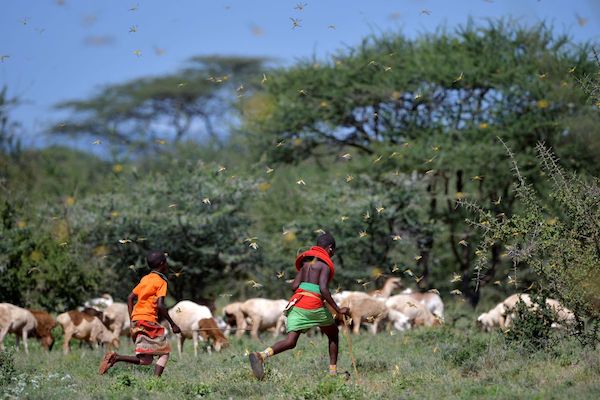
Invading locusts spring into flight from ground vegetation as young girls in traditional Samburu-wear run past to their cattle at Larisoro village near Archers Post. TONY KARUMBA / AFP via Getty Images
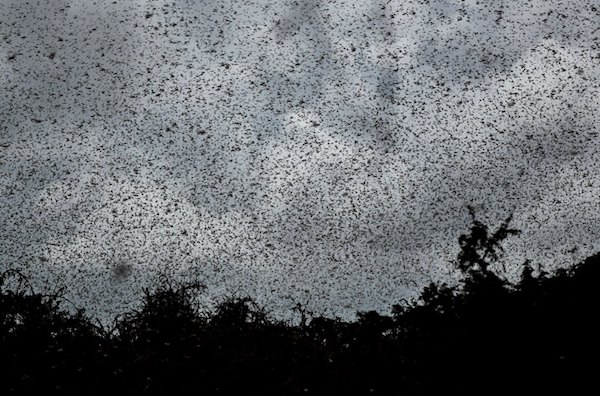
Swarms of desert locusts fly above trees in Katitika village, Kitui county, Kenya. AP Photo / Ben Curtis
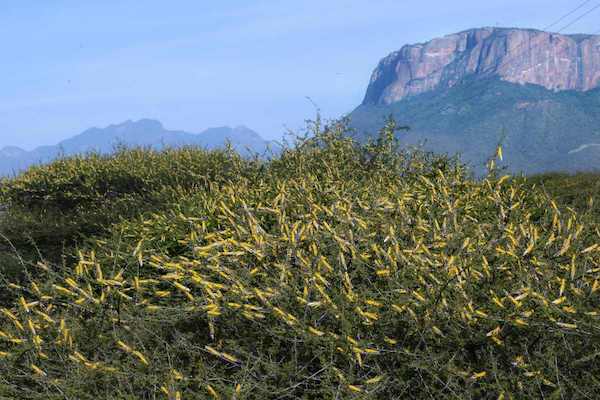
A swarm of locusts aggregates on the canopies of shrubs at Lerata village near Archers Post in Samburu county, approximately 186 miles north of kenyan capital, Nairobi. TONY KARUMBA / AFP via Getty Images
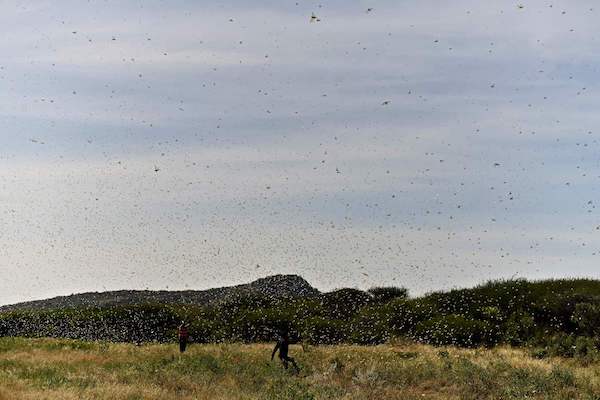
Locusts swarm from ground vegetation as people approach at Lerata village, near Archers Post in Samburu county. TONY KARUMBA / AFP via Getty Image
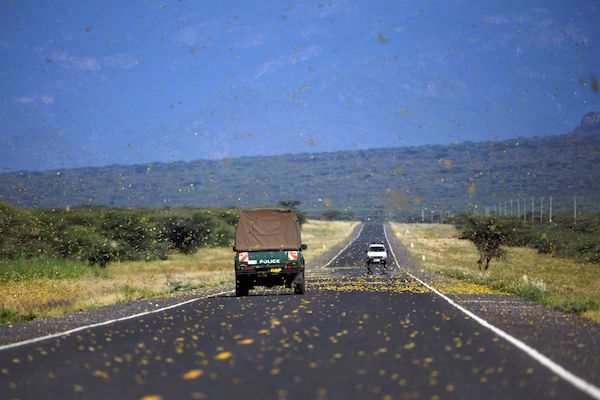
Locusts swarm across a highway at Lerata village, near Archers Post in Samburu county. TONY KARUMBA / AFP via Getty Images


Dammit. With declining insect populations around the world, why couldn’t it be a swarm of butterflies! Found an article which gives a lot of interesting facts and figures on these particular locusts, including the fact that “In one day, the average swarm can destroy around 192 million kilograms of vegetation”-
https://www.dw.com/en/locust-plague-east-africa-destructive-food/a-52165354
But it seems that East Africa is not alone here. Pakistan is also experiencing the same. Here is a link to an article on it and when you see the map showing both East Africa and Pakistan, you suspect that the warming waters of the Indian Ocean caused both outbreaks as well as other places like Oman-
https://www.dw.com/en/pakistan-declares-national-emergency-over-locust-swarms/a-52224762
you know things have really gone to hell when they start killing the butterfly workers…
https://www.theguardian.com/world/2020/feb/03/mexico-second-monarch-butterfly-sanctuary-worker-found-murdered
Fried locusts, anyone?
Just curious — If a bunch of locusts were caught in a net and ground up into a meal … I would think that meal would be an excellent base for making a chicken feed or other animal fodder. Has anything like that even been done? and if not, why not?
chickens are much better at catching them than we are.
guinneas are even better.
even my usually lumbering geese get all spry of a sudden and lunge after them.
i think storage would be an issue: they rot, and don’t dry that well, because they are rather oily. they stink terribly when they rot…especially if they get wet.(i have buckets of water under the outside lights as grasshopper traps, and learned about the smell the hard way. the grasshopper soup goes in the compost pile)
for human food, you must keep them in a jar with holes in the lid overnight, so that they evacuate their alimentary canal, then remove the legs. I like them dipped in a bit of thin tempura batter and fried in butter. Fritters, essentially. then dip them in molasses or honey. taste kind of nutty, and supposedly super-nutritious.
Locusts and honey – John the Baptist
I think in this case those “locusts” refer to the pods of the carob tree, sometimes referred to as “locust” , in the vein of us calling two certain kinds of trees the “black locust” and the “honey locust” over here.
counting my blessings, here.
our have been bad for three years running(100-200 per square yard in july), but nothing even approaching that…thank the Goddess!
my best hypothesis for our grasshopper problem is that something has happened to the birds that usually eat them…and pesticides/herbicides are the most likely culprit in that decline.this plague started a year or two after hay making became the main crop…which means former(depleted) peanut fields, which means initially weak grass. extension guy would have recommended the latest chems, at high initial rates.
it ain’t lack of winter, as i can find no correlation—if anything, we’ve had harder freezes the last several years….same with wet/dry–the giant floods(30″ in october november 18) i had hoped would knock them back, but didn’t.
I feel for those folks….it’s depressing to look out on where your food comes from and see millions of mindless critters eating it all.
but unlike them, i can just run down to the nearest grocery store.
The locusts eat crops … but don’t they also eat vegetation generally? This post considers crop destruction and food shortages. Aren’t there also some unpleasant regional climate effects from loss of vegetation? Again just curious ..
seems i’m the resident locust/grasshopper expert,lol.
i’ve boned up on my grasshopper knowledge extensively for the last 3+ years.
they occupy the same ecological niche as fire, in my opinion….providing a sort of clean slate for things to start over and/or change(as in succession, like from grassland to scrub to woodland)
i’ve watched them completely denude fifty mesquite trees, with no apparent long term damage(yet), except for no mesquite beans for 3 years running…same with acorns and pecans…which has effects on raccoons and deer and who knows what other creatures.
with oaks, they seem to prefer the weaker specimens…those with wind damage or that have been knocked over at some point. i’ve observed one of the latter totally devoid of leaves and a healthy oak of the same species and size right next to it untouched.
i’ve been expecting a commensurate population explosion of their natural predators…so far, the birds came back a little last fall(and i’ve been building bird houses every sunny day this winter), the lizards are at about the same levels as always, and the blisterbugs(who eat the grasshopper eggs) last summer(mom habitually slaughters these…i do not).
the big black ground beetles(egg eaters) have yet to make an appearance, after 3+ years.
i’ve witnessed skunks and coons and possums eating them at night…coons actually shaking branches and brush to knock them to the ground…division of labor,lol.
and i’ve seen bobcat and fox poop with grasshopper bits in it.
and i’ve seen bobcat and fox poop with grasshopper bits in it.
We had a cat that liked eating them too. A profit opportunity for a cat food company?
And I can imagine a harvesting machine like a vacuum cotton picker going to town on locusts.
As for storage, certainly freezing should work, no?
Generally, I abhor the idea of eating insects but locusts ARE kosher and who am I to argue with God?
Are insects or people the locusts?
Overpopulation and land disturbance in Africa is susceptible to locusts.
There have never been plagues of locusts hundreds of times before now?
Locusts breed when it rains a lot.
Otherwise it’s complaining about drought.